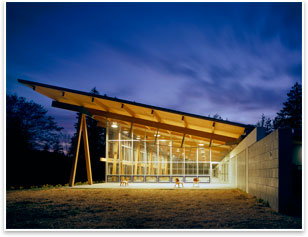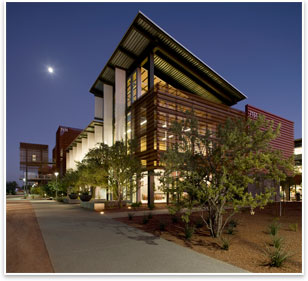The User’s Guide: Education—Where They’re Designing and Building Schools and Why
The recession’s toll on the normally resilient education design and construction industry
by Zach Mortice
Associate Editor
 How do you . . . find ways to take advantage of the relative stability of the education design and construction market? How do you . . . find ways to take advantage of the relative stability of the education design and construction market?
Summary: Despite the steep drop-off in overall construction activity forecast for this year and next, the education design and construction market is projected to experience only moderate declines or lay flat. Because school construction is funded at a state-by-state or municipal level, specific geographies of growth and decline vary greatly. Firms interested in expanding their business into the education sector are advised to pair up with more experienced firms and to take on small technical renovation projects so they can meet school stakeholders and form relationships with them.
1: The Yale University Sculpture Building and Gallery. Photo by Peter Aaron/Esto.
2: The Environmental Education/Visitor Activity Center by Bohlin Cywinski Jackson. Photo by Nic Lehoux.
3: The ASU Polytechnic Academic Complex by RSP Architects. Photo by Bill Timmerman.
Even for the normally even-keeled education design and construction
market, there are more and more reasons for clients to stop investing
in building schools. High interest ratings in still sluggish credit
markets make financing difficult to come by. Even the most richly
endowed universities have had their savings investments slashed.
State governments, which fund most school construction, are facing
budget deficits. And the worsening economic climate means that the
public has less and less tolerance for taxpayer-funded school construction
bonds and referendums.
“This is the first recession where we’ve actually seen this work hurt,” says Jim LaPosta, AIA, principal Jeter Cook and Jepson. Forty to 80 percent of his Hartford-based firm’s work comes from education projects. “That’s one of the parts that’s become a little bit concerning.”
But economic forecasters say the education architecture market will still be one of the least affected design and construction industry sectors, which is projected to experience an 11 percent drop in activity in 2009 and a 5 percent drop in 2010, according to the AIA Consensus Construction Forecast. While the hotel and commercial sectors are expected to drop by approximately 20 percent in 2009 alone, the education market will only atrophy by 7.4 percent in 2009 and 1.9 percent in 2010. Economic projections by McGraw-Hill Construction and the National Clearinghouse for Educational Facilities show the school construction market essentially laying flat through 2010.
The reasons for this relative resilience are common to many institutional building types. With school design and construction, funding is gathered much earlier than in commercial markets, and the approval process is more public and typically slower. Unlike commercial projects, schools don’t have to worry about filling their walls with tenants. Generally, the school design and construction industry runs a year behind the rest of the economy. Jim Haughey, chief economist at Reed Construction Data, predicts that the education architecture market won’t hit bottom till late this year or early 2010.
As such, voters gave school referendums and bonds a strong showing
through late 2008 in the November elections, but it’s unlikely that this kind of civic generosity will stick around as the overall economy worsens. Architects should be wary of putting school construction projects to the public at large during such insecure times, says Michael Hall, AIA, Fanning Howey’s director of marketing and director of K-12 projects. “School bond issues and school construction referendums end up being the target of a lot of voter dissatisfaction and anger when it’s not really about the need for the project at all,” he says. “It’s all about general feelings about the economy. It’s about the government.”
Fanning Howey, which specializes in K-12 school design, employs a part-time staff of six to seven retired school superintendents to help shepherd voter referendums forward.
The AIA’s Rebuild and Renew lobbying efforts for the federal stimulus package asked for $25 billion for new school construction and renovation. On January 28, the House of Representatives passed a stimulus bill that called for $20 billion worth of school modernization funding, but this measure did not survive the compromise with the Senate’s version of the bill. Though school construction isn’t funded outright, there is a $53.6 billion State Stabilization Fund, which will be used to overcome school budget shortfalls. This can include school renovations and repairs.
 State to state, town to town State to state, town to town
In the long-term, school construction
is primarily fueled by population growth and immigration, but “this
year and next, it’s about how much money you’ve got in
the bank,” says Haughey.
A mini-population boom (resulting from the children of the Baby Boomer generation entering school) propelled double digit growth in the industry through much of the 1990s and through some of the 00s. When a recovery comes, forecasters say, it’s unlikely to pick back up at this pace.
There are some broad demographic trends that will inform the education design and construction market, but since school funding is often allotted on a state-by-state or municipal basis, specific geographies of growth and decline vary greatly.
“Los Angeles alone is in the process of building 120 new schools in one city,” says Associate Director of the National Clearinghouse for Educational Facilities Judy Marks, Hon. AIA. Her organization serves as a national repository of information on school design, planning, construction, and financing. “There are some states that aren’t building that many schools.”
Haughey says that the general migration of people from industrial Rust Belt states to sunnier and westerly Sun Belt areas will affect the education architecture market. Heather Jones, a construction economist with FMI says that the hotspots for school construction form a U-shape across the nation from the west to the east: down the West Coast, across the South, and north, up the East Coast to Washington, D.C.—parallel to population growth patterns.
“Unfortunately, the places that have had huge influxes of people are the ones that have no money,” says Haughey. According the Reed analyst, Sun Belt states (California, Arizona, Florida, Nevada) that have experienced rapid population growth have spent more liberally, leaving little in the way of funding reserves. States in the Midwest and West that have managed their budgets more conservatively, are more apt to spend on education facilities, says Haughey. Such states (like Iowa, Nebraska, and Wyoming) tend to have less cyclical economies and have benefited recently from elevated agricultural commodity prices.
Some Rust Belt states otherwise hit hard by the recession have been
investing in school construction. SHW Group, a Texas-based education firm, has doubled in size in the last three years, in part because of high volumes of higher education construction in Michigan, according to their COO Kyle Bacon, AIA.
 Start small Start small
The K–12 education design and construction market is
parochial and localized, requiring deep knowledge of school stakeholders
and strong, pre-existing relationships with them. “In the K-12 market,
if you don’t know about a project until the RFP shows up, it’s
probably too late,” says Hall.
He suggests joining associational groups like the Council of Educational Facility Planners International in order to network and learn about new business opportunities. Firms that are interested in expanding their practice into the education market should also consider pairing up with an established education firm on projects. The AIA’s Committee on Architecture for Education Knowledge Community provides these kinds of opportunities.
LaPosta says that firms can also form relationships with educational clients by taking on small technical projects like window replacements or roofing. “I know a lot of small firms in Connecticut that started their school business by doing roofs,” he says. “You get in, you do a good job, you build relationships, and people get a chance to trust you.”
|



